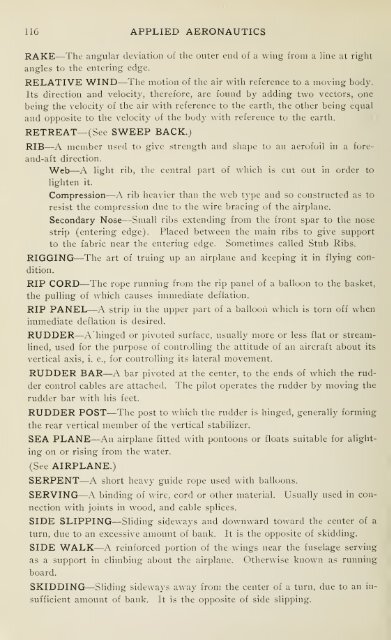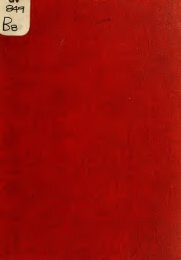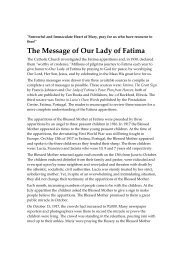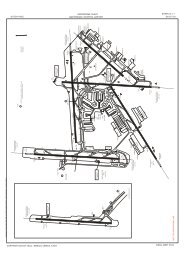Applied aeronautics; the airplane - Beeldbibliotheek
Applied aeronautics; the airplane - Beeldbibliotheek
Applied aeronautics; the airplane - Beeldbibliotheek
- No tags were found...
Create successful ePaper yourself
Turn your PDF publications into a flip-book with our unique Google optimized e-Paper software.
116 APPLIED AERONAUTICSRAKE—The angular deviation of <strong>the</strong> outer end of a wing from a line at rightangles to <strong>the</strong> entering edge.RELATIVE WIND—The motion of <strong>the</strong> air with reference to a moving body.Its direction and velocity, <strong>the</strong>refore, are found by adding two vectors, onebeing <strong>the</strong> velocity of <strong>the</strong> air with reference to <strong>the</strong> earth, <strong>the</strong> o<strong>the</strong>r being equaland opposite to <strong>the</strong> velocity of <strong>the</strong> body with reference to <strong>the</strong> earth.RETREAT— (See SWEEP BACK.)RIB—A member used to give strength and shape to an aerofoil in a foreand-aftdirection.Web—A light rib, <strong>the</strong> central part of which is cut out in order tolighten it.Compression—A rib heavier than <strong>the</strong> w^eb type and so constructed as toresist <strong>the</strong> compression due to <strong>the</strong> wire bracing of <strong>the</strong> <strong>airplane</strong>.Secondary Nose—Small ribs extending from <strong>the</strong> front sj^ar to <strong>the</strong> nosestrip (entering edge). Placed between <strong>the</strong> main ribs to give supportto <strong>the</strong> fabric near <strong>the</strong> entering edge. Sometimes called Stub Ribs.RIGGING—The art of truing up an <strong>airplane</strong> and keeping it in flying condition.RIP CORD—The rope running from <strong>the</strong> rip panel of a balloon to <strong>the</strong> basket,<strong>the</strong> pulling ofwhich causes immediate deflation.RIP PANEL— -A strip in <strong>the</strong> upper part of a ballooii which is torn off whenimmediate deflation is desired.RUDDER—A hinged or pivoted surface, usually more or less flat or streamlined,used for <strong>the</strong> purpose of controlling <strong>the</strong> attitude of an aircraft about itsvertical axis, i. e., for controlling its lateral movement.RUDDER BAR—A bar pivoted at <strong>the</strong> center, to <strong>the</strong> ends of which <strong>the</strong> ruddercontrol cables are attached.rudder bar with hisfeet.RUDDER POST—The post to which <strong>the</strong> rudder isThe pilot operates <strong>the</strong> rudder by moving <strong>the</strong>hinged, generally forming<strong>the</strong> rear vertical member of <strong>the</strong> vertical stabilizer.SEA PLANE—An <strong>airplane</strong> fitted with pontoons or floats suitable for alightingon or rising from <strong>the</strong> water.(See AIRPLANE.)SERPENT—A short heavy guide rope used with balloons.SERVING—A binding of wire, cord or o<strong>the</strong>r material. Usually used in connectionwith joints in wood, and cable splices.SIDE SLIPPING—Sliding sideways and downward toward <strong>the</strong> center ofturn, due to an excessive amount of bank. It is <strong>the</strong> opposite of skidding.SIDE WALK—A reinforced portion of <strong>the</strong> wings near <strong>the</strong> fuselage servingas a support in climbing about <strong>the</strong> air])lane. O<strong>the</strong>rwise known as runningboard.SKIDDING—Sliding sideways away from <strong>the</strong> center of a turn, due to an insufficientamount of bank. It is <strong>the</strong> opposite of side slipping.a












